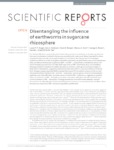Por favor, use este identificador para citar o enlazar este ítem:
http://www.alice.cnptia.embrapa.br/alice/handle/doc/1067637Registro completo de metadatos
| Campo DC | Valor | Lengua/Idioma |
|---|---|---|
| dc.contributor.author | BRAGA, L. P. P. | pt_BR |
| dc.contributor.author | YOSHIURA, C. A. | pt_BR |
| dc.contributor.author | BORGES, C. D. | pt_BR |
| dc.contributor.author | HORN, M. A. | pt_BR |
| dc.contributor.author | BROWN, G. G. | pt_BR |
| dc.contributor.author | DRAKE, H. L. | pt_BR |
| dc.contributor.author | TSAI, S. M. | pt_BR |
| dc.date.accessioned | 2017-03-24T11:11:11Z | pt_BR |
| dc.date.available | 2017-03-24T11:11:11Z | pt_BR |
| dc.date.created | 2017-03-24 | pt_BR |
| dc.date.issued | 2016 | pt_BR |
| dc.identifier.citation | Scientific Reports, v. 6, article 38923, Dec. 2016. 13 p. | pt_BR |
| dc.identifier.uri | http://www.alice.cnptia.embrapa.br/alice/handle/doc/1067637 | pt_BR |
| dc.description | For the last 150 years many studies have shown the importance of earthworms for plant growth, but the exact mechanisms involved in the process are still poorly understood. Many important functions required for plant growth can be performed by soil microbes in the rhizosphere. To investigate earthworm influence on the rhizosphere microbial community, we performed a macrocosm experiment with and without Pontoscolex corethrurus (EW+ and EW?, respectively) and followed various soil and rhizosphere processes for 217 days with sugarcane. In EW+ treatments, N2O concentrations belowground (15 cm depth) and relative abundances of nitrous oxide genes (nosZ) were higher in bulk soil and rhizosphere, suggesting that soil microbes were able to consume earthworm-induced N2O. Shotgun sequencing (total DNA) revealed that around 70 microbial functions in bulk soil and rhizosphere differed between EW+ and EW? treatments. Overall, genes indicative of biosynthetic pathways and cell proliferation processes were enriched in EW+ treatments, suggesting a positive influence of worms. In EW+ rhizosphere, functions associated with plant-microbe symbiosis were enriched relative to EW? rhizosphere. Ecological networks inferred from the datasets revealed decreased niche diversification and increased keystone functions as an earthworm-derived effect. Plant biomass was improved in EW+ and worm population proliferated. | pt_BR |
| dc.language.iso | eng | eng |
| dc.rights | openAccess | eng |
| dc.subject | Crescimento de plantas | pt_BR |
| dc.title | Disentangling the influence of earthworms in sugarcane rhizosphere. | pt_BR |
| dc.type | Artigo de periódico | pt_BR |
| dc.date.updated | 2019-11-07T11:11:11Z | pt_BR |
| dc.subject.thesagro | Minhoca | pt_BR |
| dc.subject.thesagro | Solo | pt_BR |
| dc.subject.thesagro | Rizosfera | pt_BR |
| dc.subject.thesagro | Biologia do solo | pt_BR |
| dc.subject.nalthesaurus | Earthworms | pt_BR |
| dc.subject.nalthesaurus | Rhizosphere | pt_BR |
| riaa.ainfo.id | 1067637 | pt_BR |
| riaa.ainfo.lastupdate | 2019-11-07 -02:00:00 | pt_BR |
| dc.identifier.doi | 10.1038/srep38923 | pt_BR |
| dc.contributor.institution | LUCAS P. P. BRAGA, CENA, USP; CAIO A. YOSHIURA, CENA, USP; CLOVIS D. BORGES, CENA, USP; MARCUS A. HORNS, Institute of Microbiology, Leibniz University Hannover, Germany / University of Bayreuth, Germany.; GEORGE GARDNER BROWN, CNPF; HAROLD L. DRAKE, University of Bayreuth, Germany; SIU M. TSAI, CENA, USP. | pt_BR |
| Aparece en las colecciones: | Artigo em periódico indexado (CNPF)  | |
Ficheros en este ítem:
| Fichero | Descripción | Tamaño | Formato | |
|---|---|---|---|---|
| 2016G.BrownSRDisentangling.pdf | 1.42 MB | Adobe PDF |  Visualizar/Abrir |









